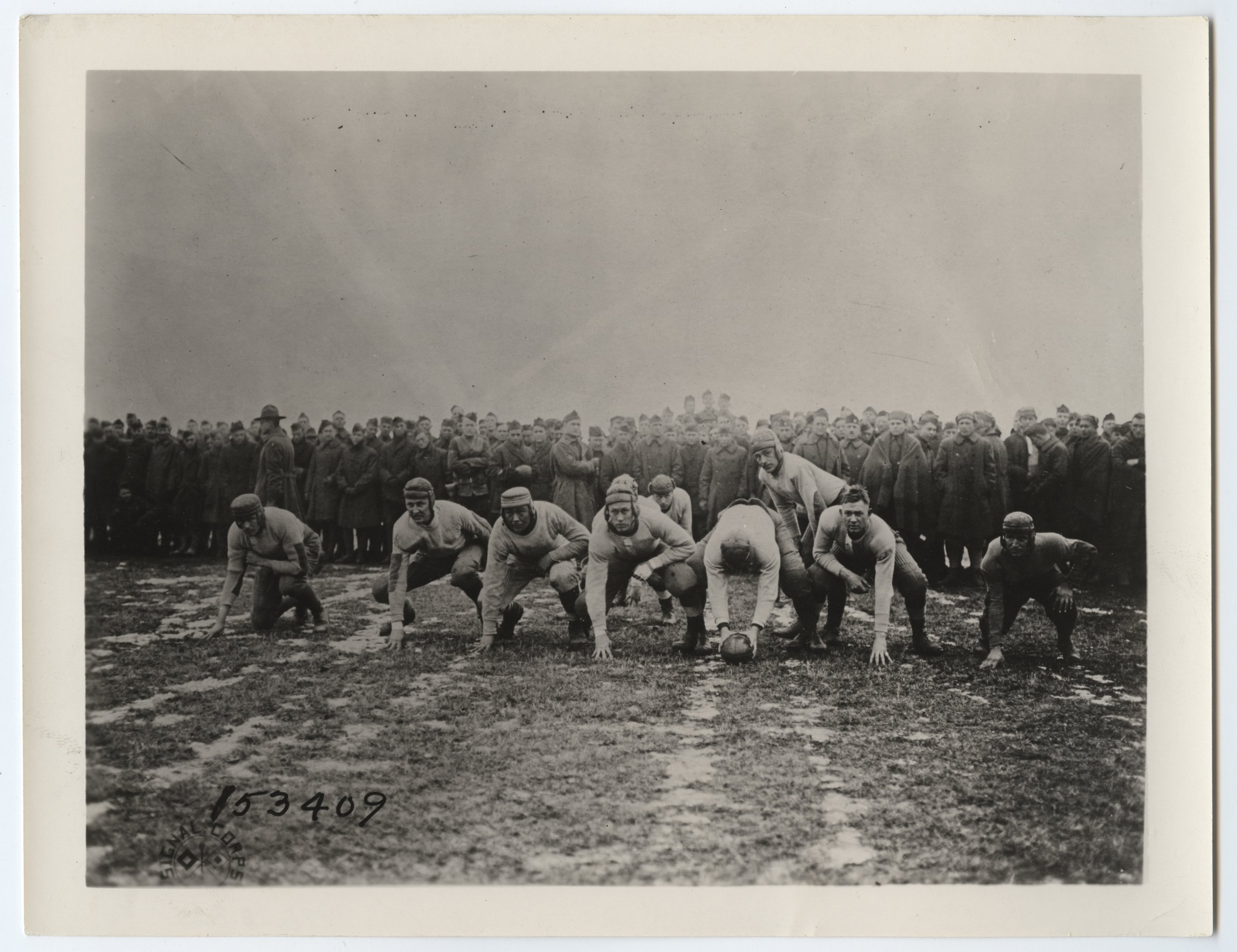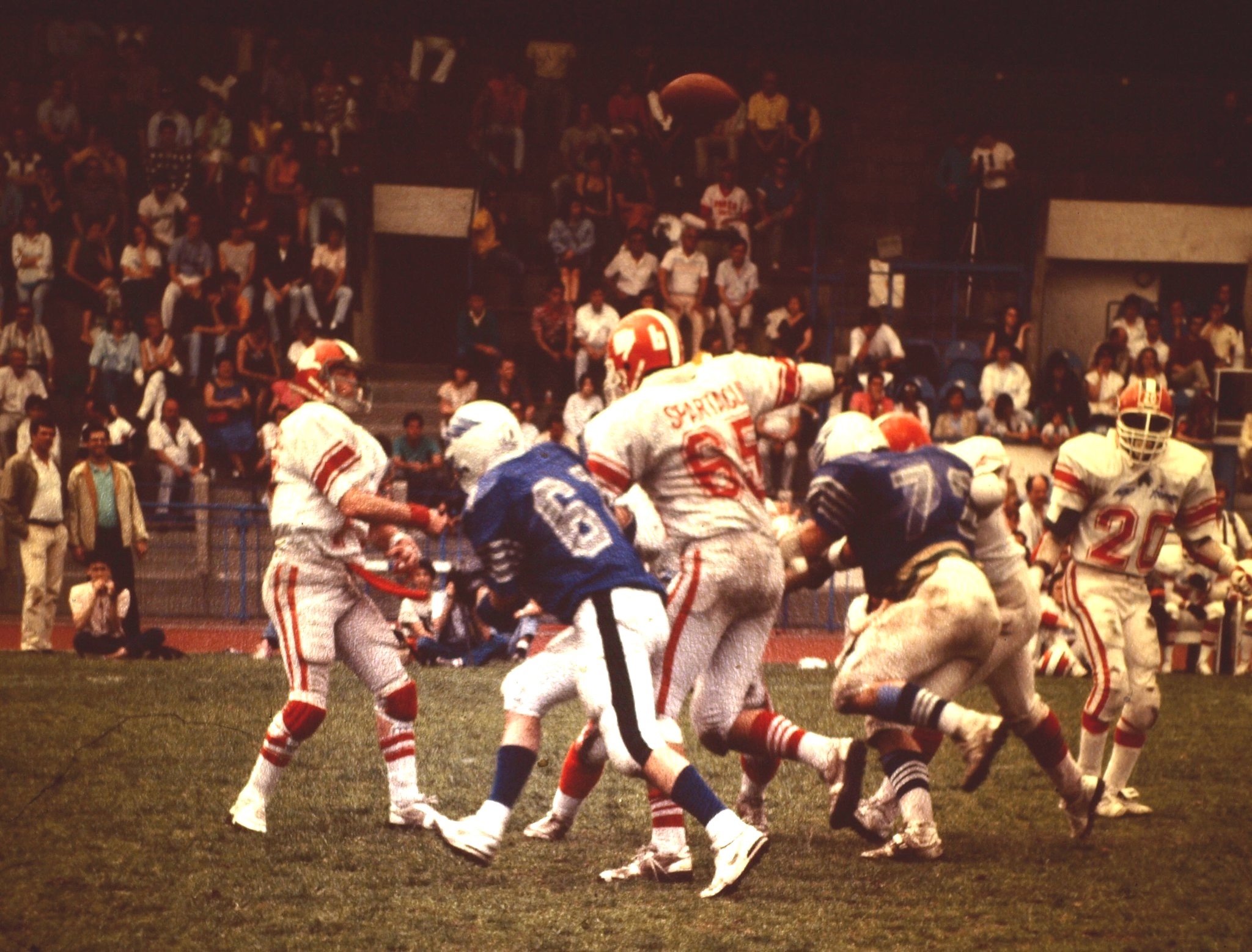American Football in France
Often hidden from sight, American football has long served as a conduit between French and Americans on both sides of the Atlantic Ocean.
Contributed By Dr. Russ Crawford
Often hidden from sight, American football has long served as a conduit between French and Americans on both sides of the Atlantic Ocean. For the first several decades, however, it was a game played in France by Americans. The sport was first exhibited in 1900 Paris and scrimmages held between the crews of visiting U.S. warships in French ports, but the Great War changed this.
The InterAllied Games in 1919. Image from Le Football: A History of American Football in France (used with permission by the National World War I Museum in Kansas City, MO via Russ Crawford).
The first American football games in France were played by soldiers of the American Expeditionary Force (AEF) in World War I. During the war, doughboys played for rest and relaxation, and to keep themselves safe from supposed temptations like....women, wine, and gambling. Similarly, after the war, AEF soldiers waiting to be demobilized played football to keep busy. These games included a division-level tournament that culminated in a championship game played at Stade Pershing in Paris as part of the Inter-Allied Games in 1919. Back in the United States, the war helped popularize football but it did not receive the same boost in France.
This changed in 1938, with concerns over renewed war building in France. Kurt Riess, a German writer working as a reporter for the French newspaper Paris Soir, had the idea that what France needed was American football. He convinced his paper to organize an exhibition tour by two all-star teams led by Fordham University head coach Jim Crowley. The two teams played six games and garnered significant press attention, at least in the buildup stage, and for the first game played in Paris.
From Le Petit Parisien, December 1, 1938. Image from Le Football: A History of American Football in France (used with permission of the Bibliothéque Nationale de France via Russ Crawford).
When the United States joined the Second World War, American servicemen continued the games in French territory, beginning with the Arab Bowl in Oran Algeria in 1944. Various teams played in “Bowl” games in Paris, Dijon, Cherbourg, and Marseilles. A scheduled Champagne Bowl was cancelled by the Nazi’s final Ardennes Offensive.
France also played an indirect role making football a better spectacle in the United States during WWII. According to Clark Shaughnessy, then coach of the Stanford Indians, the German blitzkrieg that rolled through France in 1940 inspired him to revamp his offense into what would be popularized as the T Formation. That formation featured a great deal of misdirection and trickery to confuse the defense, as had the German invasion faking the Allied armies north into Belgium before striking through the Ardennes.
Between 1952 and 1966, the Fourth and Fifth Republics, as part of NATO, allowed the United States to build military bases on French soil. By the late 1950s, teams from France began to dominate the U.S. Air Force Europe (USAFE) league. Despite the hundreds of games played on their soil, very few French citizens ever saw a football contest.
In addition to games played by USAFE teams, American high schools attached to the various French bases also played football to give their students the same prep experience as their peers back home. Some of these prep teams also played internationally, facing teams from Germany, England, and Spain.
A 1961 tour of southern France by the Supreme Headquarters Allied Powers Europe (SHAPE) Indians and the Laon Rangers included games in Toulouse and Perpignan. The tour was conceived by Marcel LeClerc, who directed the Marseilles rugby club, and who paid all of the expenses for the tour. He wanted to popularize the American sport in the south where rugby was most popular, but the effort was unsuccessful.
In 1976, Bob Kap, an entrepreneur originally from Yugoslavia, who argued soccer-style kickers were better for the NFL, began his quest to popularize football in Europe. His International Football League sponsored a tour of Europe by the Texas A&I Javelinas and the Henderson State Reddies, two top National Association of Intercollegiate Athletics (NAIA) football teams. They played one game of their series in Paris and once again garnered significant press, but only for a few days.
In 1977, Kapp convinced the semiprofessional Newton (IA) Nite Hawks and the Chicago Lions to play several games in Europe, including one in Paris and another in Lille. Though they drew decent crowds, and received some favorable press while in France, by the time the tour reached Austria things fell apart and team officials had to get a check cashed by the U.S. Embassy to pay for their hotel so they could leave for home.
Into the 1980s, others attempted to bolster the sport’s popularity in Europe via the portal of France. Jim Foster, who created the Arena Football League, took the Detroit Drive and the Chicago Bruisers to Europe after the 1989 season, where the teams played exhibitions in London and Paris. Although the games netted a number of spectators, Foster credited the games in Europe with helping spread the popularity of his new league.
The NFL also attempted to bring football to the continent with NFL Europe between 1991 and 2007, but they were unable to convince the French to take part. Several French players saw action, but the effort ultimately failed to establish big-time professional American football anywhere in Europe.
Laurent Plegelatte (left) throwing a pass against Les Anges Bleus in the 1986 Casque d'Or FFFA championship game. Image from Le Football: A History of American Football in France (via Russ Crawford).
The tables turned in 1980, however, when American football played by the French took firmer root. That year Laurent Plegelatte, a French physical education instructor in the greater Paris region, traveled to Colorado for a conference; while there, he watched practices and games at a local high school. According to Plegelatte, when a coach ridiculed the idea that Frenchmen could play football, he decided to prove the critic wrong. He then approached the owner of a sporting goods store and bought enough equipment to start a team. Within a few hours of his return to Paris, he held a practice and had formed the first all-French team – the Spartacus. Fittingly, they practiced on the grounds of Stade Pershing.
Plegelatte proved to be a visionary. He required that his players learn the sport while playing for Spartacus, and then leave to form their own squad. In this manner, within a few years there were several teams playing in and around the Paris area.
Spartacus, the Meteores, and the Anges Bleus (Blue Angels), along with others, pioneered the sport around Paris. The Blue Angels, in particular, began to elevate the level of play by bringing in American players, and Canadian coach Jacques Dussault to help improve the level of play in the league. Other teams, such as the Flash de La Courneuve, used the sport to build community in the economically blighted area where they played, and forged strong programs that continue today. Despite facing the stigma of sometimes being called “Reagan Americans,” the players became fanatics in their devotion to the unusual sport.
Canal +, the French television network, began to televise American football games in the early 1980s, which accelerated team creation, and spread the game from the capital. The Argonautes of Aix-en-Provence was a power in the 1990s. The Spartiates of Amiens, and the Black Panthers of Thonon-les-Bains had championship runs in the 2000s.
The Sparkles de Villeneuve St. Georges taken before their first game against the Spanish National Team. Image from Le Football: A History of American Football in France (photo courtesy of Rémy Issaly vis Russ Crawford).
In 2011, when Sarah Charbonneau created the Sparkles de Villaneuve St. George, women began to play as well. The Molosses d’Asniere-sur Seine, a successor team to the Sparkles, has won all of the Challenge Femin that the FFFA has held. Support from the FFFA has reportedly been grudging, and the Federation recently elevated flag football, instead of tackle, for women.
The most accomplished French player so far has been Richard Tardits, who remains the second leading sack producer in Georgia Bulldog football history. Tardits, who went out for the Bulldogs on a whim, also played professionally in the NFL for the Phoenix Cardinals and New England Patriots from 1989 to 1992 before an injury cut short his career. Jacques Accambray, a former FFFA president, played football and threw the hammer for the track team while attending Kent State University in the early 1970s. In recent years, more and more French players have found places on college teams in the United States and Canada. Purdue wide receiver Anthony Mahoungou played briefly for the Philadelphia Eagles, and most recently Jeffery M’ba signed to play with Auburn University.
Today, more than 23,000 Frenchmen, and dozens of Frenchwomen, play the game on more than 225 teams. The FFFA also sponsors junior teams, flag teams, and cheerleading competitions.
Dr. Russ Crawford is a Professor of History at Ohio Northern University who runs the Women Playing American Football Oral History Project. The University of Nebraska Press published Crawford’s Le Football: A History of American Football in France in 2016.





